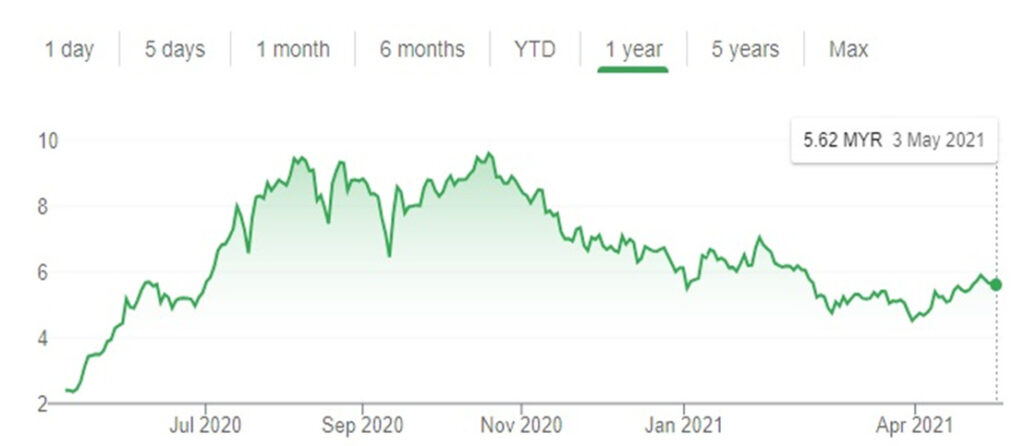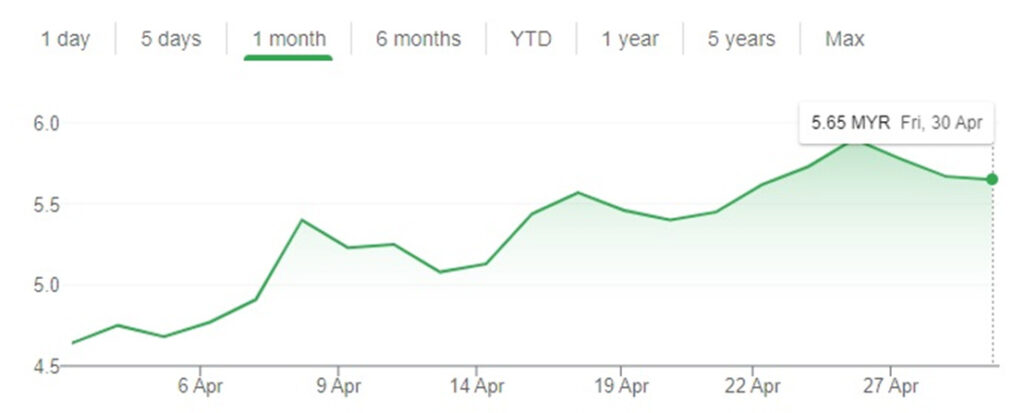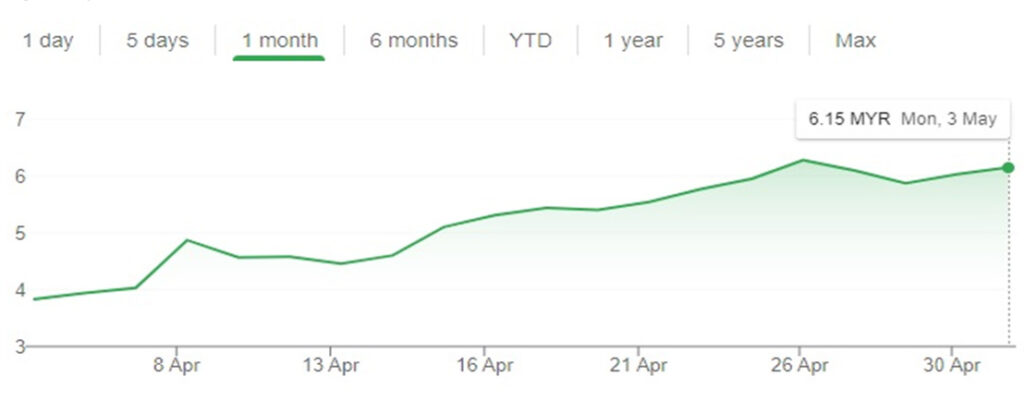Top Glove – News Flow and Stock Price Performance Dichotomy
Synopsis: In our previous insight on Top Glove, we had discussed how the stock price movement had interestingly played out over the previous months for Top Glove Corporation Berhad (Top Glove), a Malaysian rubber glove manufacturer and one of the global leaders in the industry (ESG Matters, Act Now or Repent Later: An Analysis of Top Glove, published 10th February 2021. However in recent times, the month of April has turned out to be one of the best months for the company, with its shares delivering 25% plus returns. Although Top Glove stock did benefit from the resurgence of pandemic, the most important driver for the directional change in its stock price performance was the October onwards selling that created an opportunity for investors to jump in. As per the news reports, Top Glove Corp. and Supermax Corp. were among the top three stocks on the buying list of foreign investors as of April, 2021. Supermax Corporation Berhad is one of the major players in the latex gloves market and its stock price is up more than 50% in the last one month. When comparing both the companies’ stock returns in recent times, Top Glove seems to be an underperformer. What could be next for Top Glove? We expect the stock price performance of Top Glove in the upcoming weeks to be less pronounced as compared to its April performance.
Top Glove: April’s Big Swing
Top Glove Corporation Berhad (Top Glove) is a Malaysian rubber glove manufacturer and is one of the global leaders in the industry. As such with a surge in cases and rising demand for rubber gloves, the pandemic has brought good times for the company. The stock’s 52-week high to 52-week low was 4.1x (stock’s 52-week high price was 9.77 MYR and its 52-week low was 2.36 MYR at Bursa Malaysia Exchange). But the stock has languished from October 2020 onwards because of multiple concerns. First, there were reports that cramped dormitories for labourers led to over thousands of Covid-19 cases and there were also attempts to cover up the same. Naturally, there was backlash from Institutional Shareholders. And secondly, BlackRock, the world’s largest asset manager and a strong advocate of sustainable business practices, voted against the re-election of six independent directors at the Annual General Meeting on 6th January 2021.
Fig. 1: Top Glove Stock Price over last twelve months

Source: Google
However, things have started to change for Top Glove, with April being one of the best months where the stock delivered 25% plus returns. Another thing of interest is the consistency in the stock price movement in April which is inspiring for investors.
Fig. 2: Top Glove Stock Price in April

Source: Google
What does news flow suggest?
The news flow remains mixed for the company. There were reports of significant negative developments for Top Glove in the month of April. The United States’ Withhold Release Order (WRO) on Top Glove Corp was a negative development for the rubber glove manufacturer’s sales in the North American markets. In another key development, Top Glove Corp downsized its Hong Kong initial public offering (IPO) to raise RM4.17 billion, down from the RM7.7 billion supposed to be raised initially. The official explanation was that the decision on raising less money in Hong Kong came after the glove maker took into account “the best interest of the existing shareholders of the company by minimising dilution to existing shareholders’ respective shareholding”.
- 27th April 2021 – Top Glove has resolved all indicators of forced labour. Link
- 22nd April 2021 – Top Glove downsizes Hong Kong IPO to raise RM4.17 billion instead of RM7.7 billion. Link
- 16th April 2021 – Top Glove maintains 30pc global market share target this year. Link
- 9th April 2021 – WRO has negative impact on Top Glove’s sales, earnings in North America. Link
- 8th April 2021 – Top Glove boss says group can still ship gloves produced outside Malaysia to the US. Link
- 8th April 2021 – Glove shares rise on bargain hunting as Covid-19 resurgence offers fillip to prices. Link
So what changed investors’ sentiment?
Over the last several weeks, there has been a huge resurgence globally of Coronavirus cases, thus increasing concerns that the Covid-19 pandemic is far from being under control. In countries like India and Brazil, the situation has deteriorated sharply, resulting in a massive stress on their already stretched healthcare system. As unfortunate as it is, this growing number of cases has led to an increase in interest in the global companies which stand to be the direct or indirect beneficiaries of the pandemic and the rubber glove manufacturing industry happens to be one of them. The expectation is that the increased demand from many affected countries will lead to growth in prices and better profitability for rubber glove manufacturers.
Although Top Glove did benefit from the pandemic, the most important driver for the directional change in its stock price performance was the October onwards selling that created an opportunity for investors to jump in. As per news reports, the foreign funds had again started showing significant interest in Top Glove and other rubber glove manufacturers. According to a Bloomberg report (Link), Top Glove Corp. and Supermax Corp. were among the top three stocks on the buying list of foreign investors this year as of April 2, attracting net inflows of 1.4 billion ringgit ($340 million), according to CGS CIMB Research.
Supermax Corporation Berhad is one of the major players in the latex gloves market. As per the public information available, Supermax Corp is Malaysia’s largest Own Brand Manufacturer and the world’s second largest producer of rubber gloves. The Supermax website also mentions that the company currently exports to over 160 countries worldwide, from America to Europe to Middle East, Asia and the South Pacific. Supermax Group produces up to 24 billion pieces of gloves per year, meeting approximately 12% of the world demand for latex examination gloves. The Supermax stock price is up more than 50% in the last one month. Upon comparing the recent returns of both the companies’ stock price, Top Glove comes across as an underperformer.
Fig. 3: Supermax Stock Price over last one month

Source: Google
Our take on what’s next for Top Glove?
We expect the stock price performance of Top Glove in the upcoming weeks to be less pronounced as compared to its April performance with the disclaimer being that the Coronavirus situation across the world does not deteriorate further. In case it does deteriorate, investors’ interest will be positive towards the industries that stand to benefit from the pandemic. Nevertheless, we opine that the news flow on business fundamentals is still mixed and the relatively good performance of the stock was primarily because of heightened buying by investors. But even then, the interest level in Top Glove was much lower as compared to Supermax.
The last fifteen months have been a tumultuous period for Top Glove. In the third quarter of 2020, investor sentiment improved significantly as the company started to deliver excellent operating and financial performance. As such, it doesn’t come as a surprise that the months of August and September were the time when sentiment was at its peak. However, the negative news flow, such as poor living conditions for workers, that came out in October and November hurt the stock. It also resulted in backlash from Institutional Shareholders.
After a significant correction, the stock showed some stability and consolidation in the first quarter of 2021 but the overall trend has remained weak. We think that the improvement in fundamentals and more positive perception especially on the ESG news flow will take time to settle and hence, it would be unreasonable to expect a consistent increase in stock price. It is unlikely, in the near term, that the stock price will reach the peak that was seen in the last twelve months, at least not in 2021.
How EMAlpha’s analysis of Unstructured data can help Investors
Top Glove has been one of the most interesting names from the perspective of stock price movement over 2020 and 2021 and it has been repeatedly picked up by EMAlpha AI. There are important takeaways from this:
- Can the local news flow collection pick up issues like the condition of workers, earlier than the English media? Considering how vocal some of the institutional investors have been on Sustainability and ESG issues, these are issues which matter the most. The local language along with English news analysis can be tracked for the companies experiencing ESG related issues. Considering the sensitivities involved, especially when institutional investors have invested in the stock, these issues could escalate quickly, thus impacting the stock price performance.
- Can regular analysis of social media (such as Reddit feed) be used as an input before taking an investment decision? It is here that EMAlpha’s analysis of unstructured data becomes a key tool for investors. The unstructured data analysis in other geographies can also be used to assess the potential impact on some of the larger companies. Case in point being Top Glove from Malaysia which is very similar to Supermax from Malaysia and Dipped Products of Sri Lanka, in terms of the opportunity that was created because of the Covid-19 pandemic.
- Predicting the behaviour of large institutional investors on the basis of trading information can help forecast the stock price impact. This is one of the key features of EMAlpha product as it combines technology with domain expertise. The news flow analysis provided by EMAlpha is useful in picking up the signals when the views change for institutional investors.
EMAlpha Products and Services
In most Emerging Markets, information discovery is a major challenge. For example, even if global investors do show interest, how do they solve the problem of timely access to information? The world’s largest capital allocators hold USD 60 trillion and they include GPIF (Japan), GPF (Norway), ADIA (Abu Dhabi), GIC (Singapore) etc. However, only 10% of the capital gets allocated to EMs and ~90% goes to G10. The big hurdle for EMs is: Foreign investors cannot access relevant local information in a timely fashion.
Most market participants and investors from across the world realise that the low rates in G10 makes EM attractive for investors. But, a) Information access is usually a cost and time intensive process for investors, and b) In many EMs, language is a big barrier and because of multiple regional languages, there is a significant delay before news makes it to the mainstream English language. To address these issues, you need solutions like, a) Real time news collection from multiple languages and, b) Instantaneous machine translation and text analytics leading to actionable recommendations for investors.
There are further challenges such as ensuring that companies behave responsibly and that they adopt sustainable business practices. There is a need to ensure that the investors are contributing towards making the world a better place by making investment decisions which reward responsible behaviour of companies. Case in point, ESG (Environmental, Social & Governance) which is increasingly being used as a filter for investment decisions. There are other issues as well such as which data to use and a lack of a standardized framework for evaluation.
Some of these issues are too important to be postponed to a later date and it is in this regard that EMAlpha is making its contribution. EMAlpha has developed a Flexible ESG Framework Management System which is a proprietary technology that makes ESG scores framework agnostic, thus allowing for quick adaptation. In addition, the users decide what matters to them and the EMAlpha system does a classification into E, S, G and more granular categories.
EMAlpha also has solutions for Multilingual data collection and real time targeted information which are based on proprietary processes to collect relevant data across multiple markets. The coverage expands across emerging market equity, currencies and commodities and the work has also been very successful in testing the signals in some key markets for live trading strategies. This is a continuous cycle and a virtuous loop that allows for iterative improvement through AI-human feedback.
With developments in AI and technology in areas like NLP, there are considerable new possibilities to bridge the gap in information between Emerging Markets and the more Developed Markets. This is an area which is turning out to be very exciting because some of the tools mentioned were not available even a couple of years ago. This implies that the evolution in the field will only get faster as time goes on. While the Emerging Markets and the Capital Flow Conundrum is a complex one, there is now much more hope and optimism that with the usage of technology, things will only get better.
At EMAlpha, the ESG team is doing further research on why some issues like Social get more prominence as compared to others like Environmental or Governance issues. To look at specific cases in the context of ESG is a very intense yet interesting exercise and this has been an incredible learning experience for the EMAlpha Research team. The data, information and ratings are a humongous challenge for ESG and it takes time to reach to the depth of the issues as the field is evolving very quickly.
EMAlpha is making a solid contribution in tackling these challenges. EMAlpha has solutions for ESG which are practical, user friendly and although not too simplistic yet easy to use. EMAlpha has developed a Flexible ESG Framework Management System which is a proprietary technology that makes ESG scores framework agnostic, thus allowing for quick adaptation. In addition, the users decide what matters to them and the EMAlpha system does a classification into E, S, G and more granular categories.
We strongly believe that the entire ESG ecosystem requires multiple stakeholders to pull in the right direction in order to make it operational and that will be the most critically determining factor for ESG’s success in making the corporate responsibility actually work. Most importantly, the investors should view ‘E’, ‘S’ and ‘G’ individually and should not confound issues when it comes to the comprehensive ESG evaluation. It is important to understand the right reasons behind ESG investing because this bias could hurt their investment decision making and portfolio performance.
Research Team
EM Alpha LLC
For more EMAlpha Insights on Emerging Markets, please visit https://emalpha.com/insights/. To know how you can use EMAlpha’s unstructured data and ESG (Environmental, Social and Governance) solutions for better investment decisions, please email us at [email protected].
About EMAlpha:
EMAlpha, a data analytics and investment management firm focused on making Emerging Markets (EMs) more accessible to global investors and unlocking EM investing using machines. EMAlpha’s focus is on Unstructured Data as the EMs are particularly susceptible to swings in news flow driven investor sentiment. EMAlpha works on information discovery and ESG solutions for Investors in Emerging Markets, using AI and NLP tech. Our mission is: “To help increase capital flow, in terms of FDI and FPI, to Emerging Markets by lowering information barriers using AI/NLP”. EMAlpha Products help achieve both alpha and ESG solutions and the idea is to help asset allocators, asset managers, banks and hedge funds along with companies with cost and time efficient access to relevant information. We use thoroughly researched machine learning tools to track evolving sentiment specifically towards EMs and EMAlpha pays special attention to the timely measurement of news sentiment for investors as these markets can be finicky and sentiment can be capricious. Our team members have deep expertise in research and trading in multiple Emerging Markets and EMAlpha’s collaborative approach to combining machine learning tools with a fundamental approach help us understand these markets better.
Disclaimer:
This insight article is provided for informational purposes only. The information included in this article should not be used as the sole basis for making a decision as to whether or not to invest in any particular security. In making an investment decision, you must rely on your own examination of the securities and the terms of the offering. You should not construe the contents of these materials as legal, tax, investment or other advice, or a recommendation to purchase or sell any particular security. The information included in this article is based upon information reasonably available to EMAlpha as of the date noted herein. Furthermore, the information included in this site has been obtained from sources that EMAlpha believes to be reliable; however, these sources cannot be guaranteed as to their accuracy or completeness. Information contained in this insight article does not purport to be complete, nor does EMAlpha undertake any duty to update the information set forth herein. No representation, warranty or undertaking, express or implied, is given as to the accuracy or completeness of the information contained herein, by EMAlpha, its members, partners or employees, and no liability is accepted by such persons for the accuracy or completeness of any such information. This article contains certain “forward-looking statements,” which may be identified by the use of such words as “believe,” “expect,” “anticipate,” “should,” “planned,” “estimated,” “potential,” “outlook,” “forecast,” “plan” and other similar terms. Examples of forward-looking statements include, but are not limited to, estimates with respect to financial condition, results of operations, and success or lack of success of certain investment strategy. All are subject to various factors, including, but not limited to, general and local economic conditions, changing levels of competition within certain industries and markets, changes in interest rates, changes in legislation or regulation, and other economic, competitive, governmental, regulatory and technological factors affecting the operations of the companies identified herein, any or all of which could cause actual results to differ materially from projected results.



